Part 1 [Skip to Part 2 or Part 3] [Watch TED Talk: “The Art of Stillness”]
“There is no Garden of Eden” was the judgment that greeted me, as an impressionable boy, in the pages of my teenage hero, D.H. Lawrence, “the Hesperides never were.” Lawrence was my hero, though, precisely because he could never stay fixed in any one dogma, and was intensely alive to the limitations of his own perspective. So he continued, “Yet, in our very search for them, we touch the coasts of illusion and come into contact with other worlds.” Touching the coasts of illusion was not something I was wild about at fifteen—and no one has yet to describe the incandescent English novelist as a Buddhist—but in his restless movements, both within and without, Lawrence seemed to be offering a useful challenge (and complement) to the injunction I see whenever I step into a temple in Kyoto, aimed at innocent seekers after truth: “Look Beneath Your Feet.”
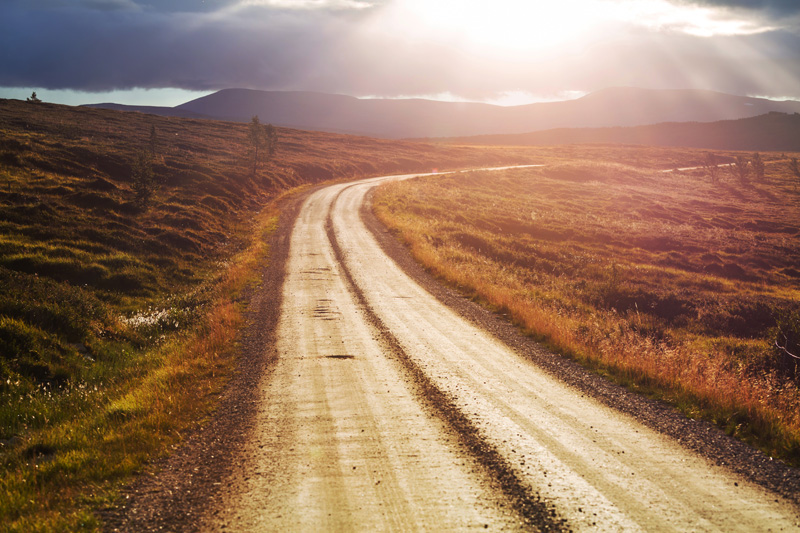
Road in Norway
A Buddhist, at least in theory, is more aware than most that travel, as Emerson had it, is a fool’s paradise if you think you can find anything abroad that you couldn’t find at home; everything we need is here and now. The Buddha himself found all the reality he required just sitting in one place. And to travel in search of anything is an even greater invitation to illusion, if only because expectation so reliably defeats itself. In the classic Sufi story, a holy fool, who’s lost his key in his living-room, circles around in the street, looking for it there. Why? Because there’s more light in the street, he says, underneath the lamps.
And yet, and yet: not many months ago, I went up to a little fishing village in northern Japan with the Dalai Lama. The place had been leveled during the tsunami eight months earlier—thousands had been washed away to sea—and, as soon as he heard about the tragedy, on the BBC, the Dalai Lama told the villagers, he knew he had to come to visit the people who remained there. There was little he could do, practically speaking, to help those who had lost almost everything, but he could at least remind them that they were not alone.
Over and over, during the week I spent with him on his annual November trip to Japan, he used the word “pilgrimage” of his trip to Tohoku. A “pilgrimage,” he might have been saying, is a journey into reality, the facts of old age, suffering and death we are obliged to observe and then to work with; a pilgrimage is a journey into others, too, the necessary complement to the four hours of meditation the Tibetan lama observes every morning alone. A pilgrimage is a journey into community and the world and what we can possibly share with others. “Going out,” as John Muir famously had it, “is really going in.”
Sitting in the little temple that had somehow withstood the oncoming water, the boxed remains of those who had no relatives to claim them at his side, the lifelong pilgrim in red robes recalled how he knew a little of what his listeners were going through because he, too, in 1959, had suddenly been forced to leave his home, without even saying goodbye to his friends “and one small dog.” A few days later, even as he drew closer to freedom, he heard that many of those he’d left behind had been killed.
*****
Part 2 [Return to Part 1] [Watch TED Talk: “The Art of Stillness”]
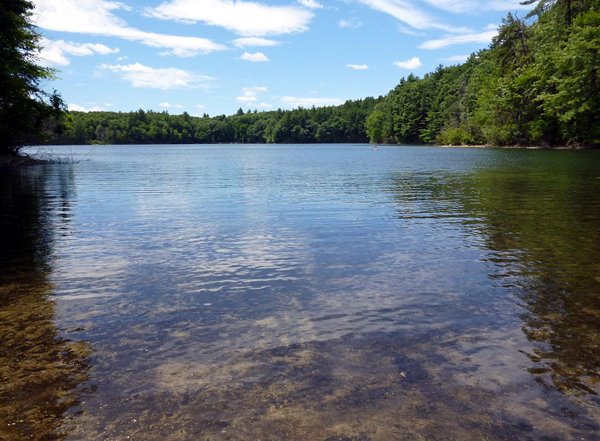
Walden Pond
Nearly all my travels, I sometimes feel, have been an attempt to journey deeper into the wisdom of my favorite traveler—and Emerson’s friend—Henry David Thoreau: “It is not worth the while to go round the world to count the cats in Zanzibar.” Thoreau had helped oversee the first translation ever of the Lotus Sutra into English (from French) a few years before he wrote those words, and had given us all a bracing example of how real exploration and truth come from sitting in one place, seeing through—in every sense of those words—all the delusions and projections we foist upon the world, especially when we assume that real life or understanding are happening somewhere else. He found India, China, Persia in Walden Pond; he found life and death and friendship and solitude.
“I measure distance inward,” he pointed out, and “to travel and ‘descry new lands’ is to think new thoughts and have new imaginings.” And yet these new imaginings and thoughts sometimes come to us most powerfully when we’re surrounded by the alien, or what we cannot understand, and the very act of taking off on a journey speaks for a kind of openness and ripeness that is in fact the first step on the road to transformation. It’s a public recognition that you don’t know everything, and that some of those things can come to you as readily on the road as on the mat; it’s a way of setting your senses at the level marked “ON,” slapping yourself awake and trying to join that much larger sense of self—or non-self—we sometimes lose when we’re sleepwalking through our lives.
And so I take myself off, often to pilgrimage spots sacred to other people—Jerusalem, Varanasi, Koyasan, the rich red interior of Australia—in order to witness the truths of the billions outside myself. Go to the Jokhang Temple at the center of Lhasa and, in its flickering candlelight, see the excited faces, the tears, the deeply human hopes that people are bringing to its statues, many of them having traveled thousands of miles to be there, some having prostrated every step of the way.
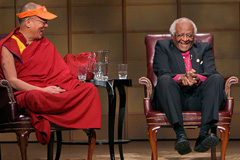
HH. the Dalai Lama with Bishop Tutu
(Photo: Carey Linde)
See the Dalai Lama himself, born to a very isolated land, visibly savoring the opportunity to travel and learn from other traditions, while refining and deepening his clear and objective sense of what the world is. Like the man he calls his “boss,” the Buddha, this doctor of the mind realizes that the first mandate of any physician is, as it were, to take the temperature and assess the condition of his patient, whether that’s himself or someone sitting outside himself; he also reminds us that the first mandate of any patient is to go out and see the doctor—who is not always, or unfailingly, himself.
From Basho to Thich Nhat Hanh, Buddhists have traveled, precisely to remind themselves of the importance of alertness (“Develop a mind that alights nowhere,” as the Lotus Sutra says), even if they never forget that the core of their practice is stillness. Physical movement is not in itself important, but it can be the catalyst, as Lawrence pointed out, to being moved or taken out of yourself; one of the easiest ways of jolting oneself awake and free of habits and assumptions. Look outside your window; walk outside your room. Drive across town to where three Vietnamese in their restaurant are bringing almost unimaginable stories of suffering and persistence to the town in which you were born.
Why go round the world to count the cats in Zanzibar, I tell my beloved teacher Thoreau? Because you have something to give those cats, beyond just counting them. Because counting them is how you can get them placed on an “endangered species” list and make sure they have a future. Because counting the cats in Zanzibar is a way of putting Santa Cruz in perspective. Because the fellow travelers you meet along the road to Zanzibar may have so much in common with you that you can learn from them, and give to them, as you could not so easily do at home.
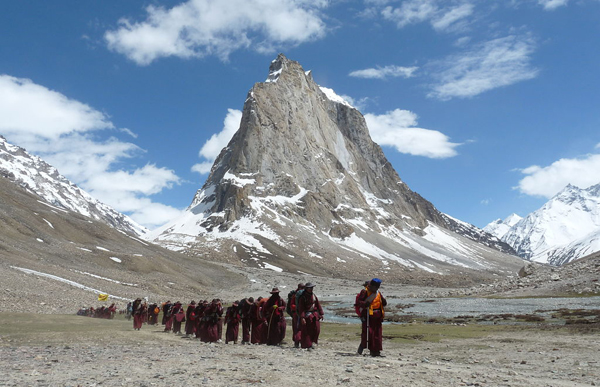
Pilgrimage in the Himalayas, from Manali to Ladakh (Photo: Drukpa Publications)
One of the great pilgrimage stories in any tradition, surely, is The Snow Leopard, by Peter Matthiessen. At the very dawn of his Zen studies, Matthiessen goes, with a professional zoologist, to count the cats in Inner Dolpo and to set eyes on one of the world’s rare and elusive creatures. But he’s also traveling, we soon realize, to see through the folly of such a venture (for him, not a professional zoologist). He’s traveling to look past the delusions of travel, to come face to face with the world and the memory of the young wife he’s just lost to cancer, so easily sidestepped if he were to stay at home. He’s traveling to see how the Buddhism he’s beginning to learn about instructs and guides those born to the tradition; he’s traveling into isolation and high altitudes to confront his own anger and restlessness and spiritual ambition.
He didn’t see the snow leopard, which makes the whole trip worthwhile.
It’s not pilgrimage, in other words, that’s our undoing; it’s the thought that we will get anything out of it. Become a pilgrim with no agenda—no hope of finding anything—and who knows what may come to you? The problem is rarely in the activity, but in the hopes that we bring to it; everything can be a pilgrimage—even a trip to a tsunami-stricken fishing village—if only you can approach it in the right spirit, with clear-eyed attention.
Part 3 [Return to Part 1] [Watch TED Talk: “The Art of Stillness”]
There is humility in the act of pilgrimage, akin to the act of bowing; you’re surrendering your own path to follow where others have gone before. It puts you in place, in that sense, and your intentions in perspective. There’s community, of course, because you’re journeying with all those others, across centuries and continents, who have also traveled to Bodh Gaya or Sarnath and, as much as anything, you’re walking in their footsteps, and in their shoes. There’s truthfulness in the act, if it can get you out of your head, the place where you end up when sitting still lacks discipline or direction. There’s kindness, if the cats of Zanzibar need something you can give them, even if it’s only (as with the snow leopard) the wisdom to leave them alone.
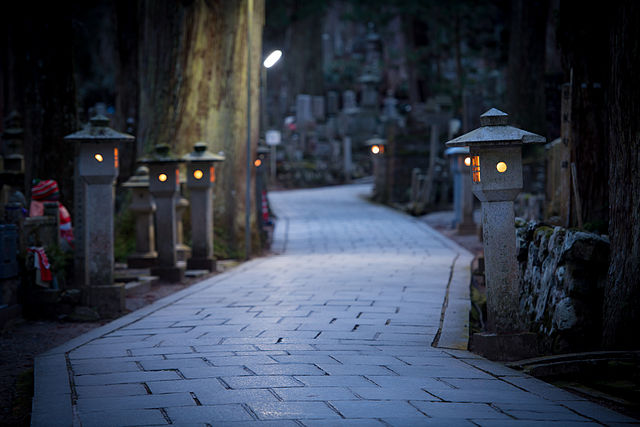
Okunion Cemetery on Mount Koya (Photo: Jordy Meow)
On his same trip to Japan last November, the Dalai Lama made a pilgrimage to Koyasan, the mountain sacred to practitioners in the Shingon sect of Buddhism, and one of the country’s central pilgrimage sites. At the top of the mountain in the center of the central island, not far from Osaka, he arrived at a place that has little other than 200,000 graves, groves of giant cedar trees that have been there for eight hundred years and 117 Shingon temples, sustaining a meditative tradition that goes back to Kobo Daishi, who founded the first temple on the mountain 1200 years ago. Sleeping on tatami mats and eating Japanese vegetarian food three times a day was not always easy for the Tibetans who were traveling with His Holiness. But one of them, a high lama himself, told me that, for all the discomforts—maybe because of them—he was able to meditate with a clarity and intensity not easy to find anywhere in the world. As if by contagion, and drawing on the energy of the hundreds of monks all around, the yamabushi (or mountain ascetics) with their strange shamanic outfits among the trees, the busloads of pilgrims all in white who had passed through 88 temples on the island of Shikoku to come to this great climax of their journeying, he could plug himself into something larger than himself, and new to him.
I came back home, after spending a week with the Tibetans, and reflected on how there are pilgrims in almost every tradition, but Siddhartha Gautama, the Dalai Lama’s “boss,” was one of those who had most stressed (in his example and his words) the necessity of leaving one’s gilded palace behind, in order to meet what’s real and see how the other half (which is to say, every sentient being but yourself) live. He’d even had to leave the people he loved and the life he knew—like the Dalai Lama in 1959—in order to be of service to them. When the Dalai Lama used the word “pilgrim,” he wasn’t, as ever, being casual.
The Buddha himself, of course, traveled for six years to see through the lures of austerity as much as of indulgence and to learn what teachers couldn’t offer him and what he could locate only in himself. He slept in graveyards and on beds of thorns; he ate only a single grain of rice at times and sometimes, it’s said, held his breath until he almost expired.
That act of directed journeying was part of what has moved people from every tradition—whether their names are Somerset Maugham or Hermann Hesse or, in fact, D.H. Lawrence—to take him as an inspiration, and a fellow traveler who was responding to some intuition that said that what he saw in his enclosure wasn’t everything. I remember how, when I left my own enchanted garden in a tiny way at the age of twenty-nine, quitting my apartment on Park Avenue South and my 25th-floor office in Rockefeller Center to go and live in a monastery in Kyoto, I took heart from the Buddha’s precedent and felt that a wise man had walked this path before me, aware that there must be something more in a life than just external rewards and a child’s notion of success.
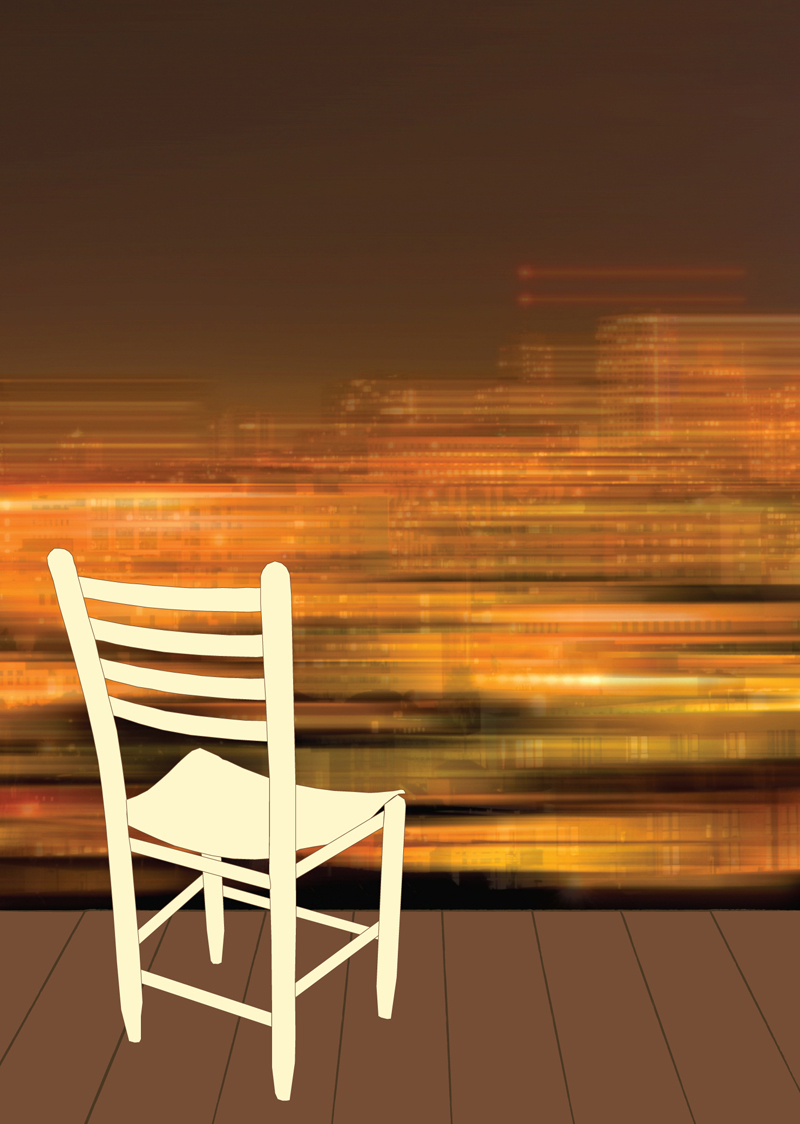 Of course the monastery couldn’t be the place I’d romantically fashioned in my head, but I had to go there to find that, and in the finding, to realize that simple alternatives to worldliness were likely to be as much a dead end as a resume unless they were accompanied by a wide-awake eye and a spirit of discernment. The Buddha found what he had to see by sitting still, but even he had to travel to get to that point, see through the other roads that would lead nowhere and, with Peter Matthiessen, come finally to the understanding that the truth we’re looking for is no further than the hair on our arms.
Of course the monastery couldn’t be the place I’d romantically fashioned in my head, but I had to go there to find that, and in the finding, to realize that simple alternatives to worldliness were likely to be as much a dead end as a resume unless they were accompanied by a wide-awake eye and a spirit of discernment. The Buddha found what he had to see by sitting still, but even he had to travel to get to that point, see through the other roads that would lead nowhere and, with Peter Matthiessen, come finally to the understanding that the truth we’re looking for is no further than the hair on our arms.
Christians and Muslims observe great and classic pilgrimages, and so do people from every tradition, but the Buddha, perhaps, taking the Middle Way and always reminding us that even our destination is unfixed, and perhaps illusory, is every walker’s special friend. Those who journey with him know that they may not come to knowledge so much as a deepened sense of their own ignorance. Even after he arrived at the Bodhi tree, Siddhartha had to sit through night after night before finally waking up to the truth he’d been carrying with him every moment.
And then, of course, he took to the road again, for the next forty-five years, across the plains and cities of the central Gangetic plain, if only to tell people to become lamps unto themselves. His very last words seem to suggest that the journey is perpetual: “All created things move on. Keep striving with diligence.”
“In one sense we are always traveling,” Thomas Merton wrote, “traveling as if we did not know where we are going. In another sense we have already arrived.” All our lives, the Buddha was saying on his path, are a journey towards recognizing where we’ve been all along.
__________
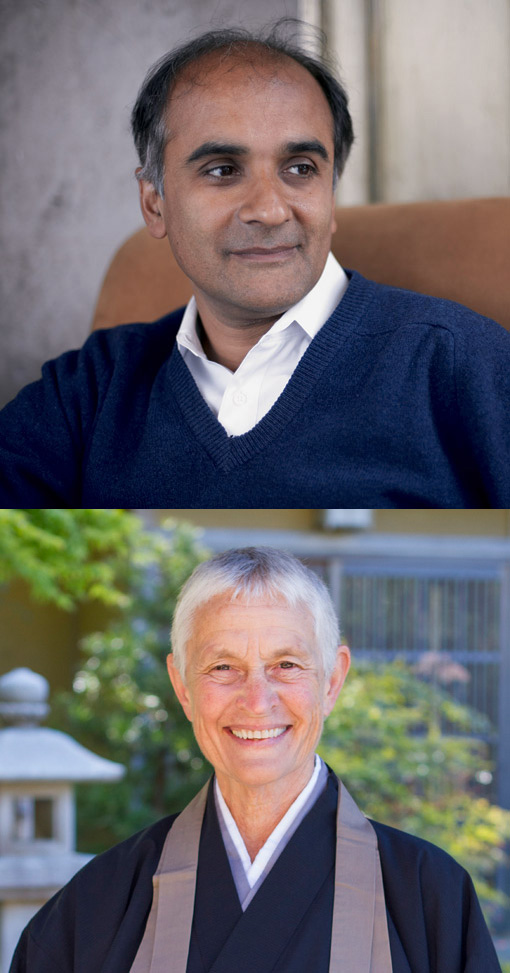
Pico Iyer (top, © Derek Shapton) and Fu Schroeder (© Anita Bowen Photography).
We hope you enjoyed all three parts of this essay, which was published in Tricycle magazine (fall 2012) and included in The Best Buddhist Writing 2013, edited by Melvin McLeod and the editors of the Shambhala Sun.
As prolific a traveler as he is a journalist, author and lecturer, surprisingly Pico Iyer chooses a simple life without a cell phone, printer or any media, having once left a fast-paced life in Midtown Manhattan for the backstreets of Kyoto, Japan. For more than a quarter-century, he’s written regularly for Time, the New York Times, and many others, and his TED talks have reached millions of viewers. His book The Open Road was based on over three decades of conversation with the Dalai Lama, though Iyer himself claims no religion.
San Francisco Zen Center is pleased to present two special events with Pico Iyer and Abbess Furyu Schroeder at Grace Cathedral on July 24-25. See these pages for details:
The Art of Stillness
An evening with Pico and Fu, Friday, July 24, 7:30 – 9 pm
Journeys into Stillness
A daylong workshop with Pico and Fu, Saturday, July 25,
10 am – 5:30 pm











